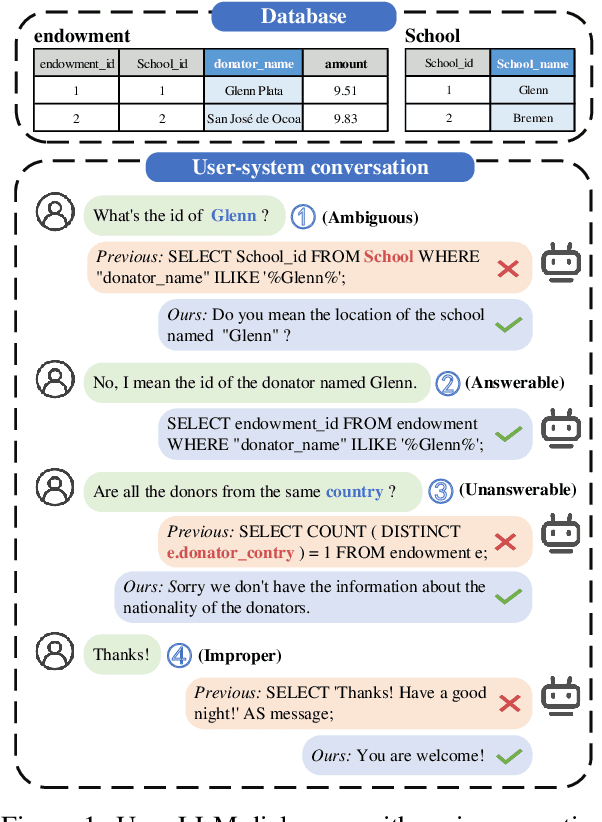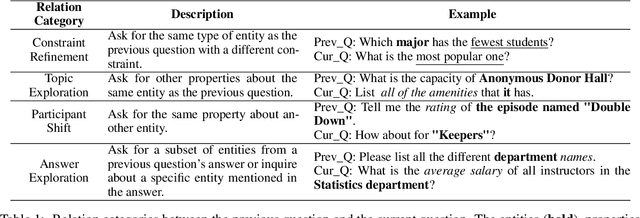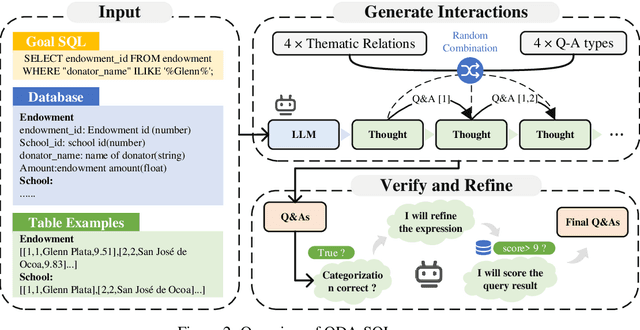Chuanyi Liu
SPFT-SQL: Enhancing Large Language Model for Text-to-SQL Parsing by Self-Play Fine-Tuning
Sep 04, 2025Abstract:Despite the significant advancements of self-play fine-tuning (SPIN), which can transform a weak large language model (LLM) into a strong one through competitive interactions between models of varying capabilities, it still faces challenges in the Text-to-SQL task. SPIN does not generate new information, and the large number of correct SQL queries produced by the opponent model during self-play reduces the main model's ability to generate accurate SQL queries. To address this challenge, we propose a new self-play fine-tuning method tailored for the Text-to-SQL task, called SPFT-SQL. Prior to self-play, we introduce a verification-based iterative fine-tuning approach, which synthesizes high-quality fine-tuning data iteratively based on the database schema and validation feedback to enhance model performance, while building a model base with varying capabilities. During the self-play fine-tuning phase, we propose an error-driven loss method that incentivizes incorrect outputs from the opponent model, enabling the main model to distinguish between correct SQL and erroneous SQL generated by the opponent model, thereby improving its ability to generate correct SQL. Extensive experiments and in-depth analyses on six open-source LLMs and five widely used benchmarks demonstrate that our approach outperforms existing state-of-the-art (SOTA) methods.
Exploring the Landscape of Text-to-SQL with Large Language Models: Progresses, Challenges and Opportunities
May 28, 2025Abstract:Converting natural language (NL) questions into SQL queries, referred to as Text-to-SQL, has emerged as a pivotal technology for facilitating access to relational databases, especially for users without SQL knowledge. Recent progress in large language models (LLMs) has markedly propelled the field of natural language processing (NLP), opening new avenues to improve text-to-SQL systems. This study presents a systematic review of LLM-based text-to-SQL, focusing on four key aspects: (1) an analysis of the research trends in LLM-based text-to-SQL; (2) an in-depth analysis of existing LLM-based text-to-SQL techniques from diverse perspectives; (3) summarization of existing text-to-SQL datasets and evaluation metrics; and (4) discussion on potential obstacles and avenues for future exploration in this domain. This survey seeks to furnish researchers with an in-depth understanding of LLM-based text-to-SQL, sparking new innovations and advancements in this field.
QDA-SQL: Questions Enhanced Dialogue Augmentation for Multi-Turn Text-to-SQL
Jun 15, 2024



Abstract:Fine-tuning large language models (LLMs) for specific domain tasks has achieved great success in Text-to-SQL tasks. However, these fine-tuned models often face challenges with multi-turn Text-to-SQL tasks caused by ambiguous or unanswerable questions. It is desired to enhance LLMs to handle multiple types of questions in multi-turn Text-to-SQL tasks. To address this, we propose a novel data augmentation method, called QDA-SQL, which generates multiple types of multi-turn Q\&A pairs by using LLMs. In QDA-SQL, we introduce a novel data augmentation method incorporating validation and correction mechanisms to handle complex multi-turn Text-to-SQL tasks. Experimental results demonstrate that QDA-SQL enables fine-tuned models to exhibit higher performance on SQL statement accuracy and enhances their ability to handle complex, unanswerable questions in multi-turn Text-to-SQL tasks. The generation script and test set are released at https://github.com/mcxiaoxiao/QDA-SQL.
First-principles Based 3D Virtual Simulation Testing for Discovering SOTIF Corner Cases of Autonomous Driving
Jan 22, 2024Abstract:3D virtual simulation, which generates diversified test scenarios and tests full-stack of Autonomous Driving Systems (ADSes) modules dynamically as a whole, is a promising approach for Safety of The Intended Functionality (SOTIF) ADS testing. However, as different configurations of a test scenario will affect the sensor perceptions and environment interaction, e.g. light pulses emitted by the LiDAR sensor will undergo backscattering and attenuation, which is usually overlooked by existing works, leading to false positives or wrong results. Moreover, the input space of an ADS is extremely large, with infinite number of possible initial scenarios and mutations, along both temporal and spatial domains. This paper proposes a first-principles based sensor modeling and environment interaction scheme, and integrates it into CARLA simulator. With this scheme, a long-overlooked category of adverse weather related corner cases are discovered, along with their root causes. Moreover, a meta-heuristic algorithm is designed based on several empirical insights, which guide both seed scenarios and mutations, significantly reducing the search dimensions of scenarios and enhancing the efficiency of corner case identification. Experimental results show that under identical simulation setups, our algorithm discovers about four times as many corner cases as compared to state-of-the-art work.
ZO-AdaMU Optimizer: Adapting Perturbation by the Momentum and Uncertainty in Zeroth-order Optimization
Dec 23, 2023Abstract:Lowering the memory requirement in full-parameter training on large models has become a hot research area. MeZO fine-tunes the large language models (LLMs) by just forward passes in a zeroth-order SGD optimizer (ZO-SGD), demonstrating excellent performance with the same GPU memory usage as inference. However, the simulated perturbation stochastic approximation for gradient estimate in MeZO leads to severe oscillations and incurs a substantial time overhead. Moreover, without momentum regularization, MeZO shows severe over-fitting problems. Lastly, the perturbation-irrelevant momentum on ZO-SGD does not improve the convergence rate. This study proposes ZO-AdaMU to resolve the above problems by adapting the simulated perturbation with momentum in its stochastic approximation. Unlike existing adaptive momentum methods, we relocate momentum on simulated perturbation in stochastic gradient approximation. Our convergence analysis and experiments prove this is a better way to improve convergence stability and rate in ZO-SGD. Extensive experiments demonstrate that ZO-AdaMU yields better generalization for LLMs fine-tuning across various NLP tasks than MeZO and its momentum variants.
State-of-the-art optical-based physical adversarial attacks for deep learning computer vision systems
Mar 22, 2023



Abstract:Adversarial attacks can mislead deep learning models to make false predictions by implanting small perturbations to the original input that are imperceptible to the human eye, which poses a huge security threat to the computer vision systems based on deep learning. Physical adversarial attacks, which is more realistic, as the perturbation is introduced to the input before it is being captured and converted to a binary image inside the vision system, when compared to digital adversarial attacks. In this paper, we focus on physical adversarial attacks and further classify them into invasive and non-invasive. Optical-based physical adversarial attack techniques (e.g. using light irradiation) belong to the non-invasive category. As the perturbations can be easily ignored by humans as the perturbations are very similar to the effects generated by a natural environment in the real world. They are highly invisibility and executable and can pose a significant or even lethal threats to real systems. This paper focuses on optical-based physical adversarial attack techniques for computer vision systems, with emphasis on the introduction and discussion of optical-based physical adversarial attack techniques.
Generative Data Augmentation for Non-IID Problem in Decentralized Clinical Machine Learning
Dec 02, 2022



Abstract:Swarm learning (SL) is an emerging promising decentralized machine learning paradigm and has achieved high performance in clinical applications. SL solves the problem of a central structure in federated learning by combining edge computing and blockchain-based peer-to-peer network. While there are promising results in the assumption of the independent and identically distributed (IID) data across participants, SL suffers from performance degradation as the degree of the non-IID data increases. To address this problem, we propose a generative augmentation framework in swarm learning called SL-GAN, which augments the non-IID data by generating the synthetic data from participants. SL-GAN trains generators and discriminators locally, and periodically aggregation via a randomly elected coordinator in SL network. Under the standard assumptions, we theoretically prove the convergence of SL-GAN using stochastic approximations. Experimental results demonstrate that SL-GAN outperforms state-of-art methods on three real world clinical datasets including Tuberculosis, Leukemia, COVID-19.
Fed-TDA: Federated Tabular Data Augmentation on Non-IID Data
Nov 22, 2022Abstract:Non-independent and identically distributed (non-IID) data is a key challenge in federated learning (FL), which usually hampers the optimization convergence and the performance of FL. Existing data augmentation methods based on federated generative models or raw data sharing strategies for solving the non-IID problem still suffer from low performance, privacy protection concerns, and high communication overhead in decentralized tabular data. To tackle these challenges, we propose a federated tabular data augmentation method, named Fed-TDA. The core idea of Fed-TDA is to synthesize tabular data for data augmentation using some simple statistics (e.g., distributions of each column and global covariance). Specifically, we propose the multimodal distribution transformation and inverse cumulative distribution mapping respectively synthesize continuous and discrete columns in tabular data from a noise according to the pre-learned statistics. Furthermore, we theoretically analyze that our Fed-TDA not only preserves data privacy but also maintains the distribution of the original data and the correlation between columns. Through extensive experiments on five real-world tabular datasets, we demonstrate the superiority of Fed-TDA over the state-of-the-art in test performance and communication efficiency.
Once is Enough: A Light-Weight Cross-Attention for Fast Sentence Pair Modeling
Oct 11, 2022



Abstract:Transformer-based models have achieved great success on sentence pair modeling tasks, such as answer selection and natural language inference (NLI). These models generally perform cross-attention over input pairs, leading to prohibitive computational costs. Recent studies propose dual-encoder and late interaction architectures for faster computation. However, the balance between the expressive of cross-attention and computation speedup still needs better coordinated. To this end, this paper introduces a novel paradigm MixEncoder for efficient sentence pair modeling. MixEncoder involves a light-weight cross-attention mechanism. It conducts query encoding only once while modeling the query-candidate interaction in parallel. Extensive experiments conducted on four tasks demonstrate that our MixEncoder can speed up sentence pairing by over 113x while achieving comparable performance as the more expensive cross-attention models.
 Add to Chrome
Add to Chrome Add to Firefox
Add to Firefox Add to Edge
Add to Edge